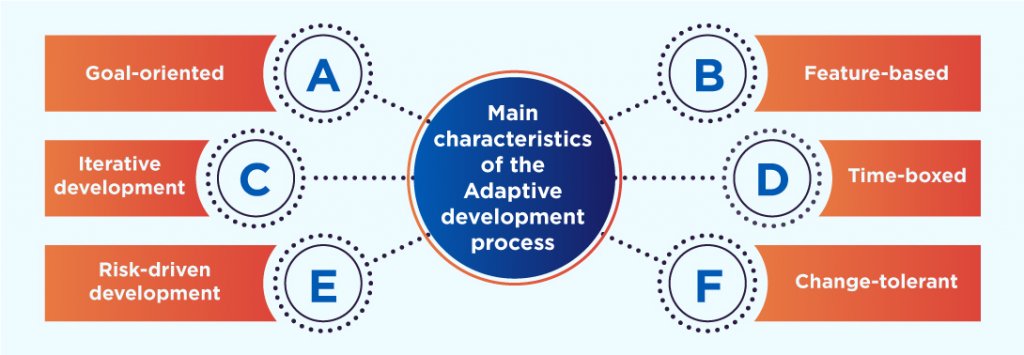- Introduction:
-
History of Adaptive Software Development
-
What is Adaptive Software Development?
- Adaptive software development lifecycle
- Adaptive software development advantages and disadvantages
- What are the key principles of Adaptive Software Development ?
- Successful products developed in adaptive software development lifecycle
- Main characteristics of the Adaptive development process
-
Comparison of ASD with other methodologies
- Why should you use adaptive software development for your product development ?
Introduction:
Success of a software mainly hinges on the types of methodology or strategy implemented. Many organizations have experienced downfalls and have been hit very badly indue to software errors which has further cost additional expenses. Since there are many software development strategies, it becomes difficult to choose the right one. These days, developers implement diverse strategies and methodologies to create and deliver quality software products. The continuous paves the path for new methods to overcome the upcoming challenges during the software development process.
Adaptive software development refers to one such predecessor of agile development methodology. It caters to changing demands and requirements to bring out flexibility, collaboration, and persistent improvements to the project. In general terms, ASD directs continuous learning and improvements, which are crucial throughout the software development phase.
There are many types of software development methodologies, but today, we will focus on what Adaptive Software development is and how this methodology will make a profound impact on the software development industry in 2024.
History of Adaptive Software Development
In the early 90s, John Highsmith and Sam Bayer introduced RAD to carry out shorter iterations and bring agility to the organization, as both of these concerns were falling short in the waterfall-like approach. Adaptive software development was first coined in the early 90’s by John Highsmith and Sam Bayer. However, later, due to the risk of hacking and the shortage of software engineering practices, they considered an alternative by applying best practices to RAD and developed RADical Software Development. Soon, working with clients, they discovered these approaches were not enough.
Later, they introduced Adaptive software development as one of the most iterative and reduced interval versions of the RAD (Rapid Application Development). ASD was brought forward due to the inspiration from the rising spike in development approach, which encourages collaboration within the organization and with the clients. This methodology not only involved proper collaboration but also ensured that the client remained in the loop during every phase of the software development.
Adaptive software development is considered one of the most modern development processes. It is one of the most innovative alternatives to waterfall methodology.
What is Adaptive Software Development?
As we all know, in general terminology, adaptive means the ability to change to suit the changing conditions. Adaptive software development, on the other hand, means effectively accommodating to the changing conditions or market demands by developing the products with lightweight planning and persistent learning.
Adaptive software development is the go-to method for developing complex systems, keeping the minimalist approach in mind. In ASD, projects go through an iterative cycle. Therefore, the adaptive process pushes the organizational teams to build the software by following the three-phase process, which includes speculating, collaborating, and learning. This method is quite close to agile development. Let us know about it in detail.
Adaptive software development lifecycle

a) Speculation
ASD framework is entirely distinct from other methodologies; it doesn’t prioritize the “Plan” phase, which is the initial phase of the software development lifecycle. Consequently, during this phase, ASD considers the iteration cycle to accomplish the project goals. Speculation phase gives the opportunity for exploration and experimentation.
b) Collaboration
Collaboration is the phase where ASD focuses on bringing teams together to utilize their collective experience & knowledge. During this phase, actual development emerges for intricate or enterprise applications. Here, the team works towards a common goal of finishing predictive tasks and prepares for the modifications caused by the latest technology, potential stakeholders, or developing requirements.
c) Learning
In this phase, teams execute short iterations of the design, build, and test cycles. This iteration allows the teams to gather small mistakes and ultimately resolve them. This phase is reviewed with technical as well as customer point of view. Moreover, the team is also monitored to get a better idea about the scope of improvements.
Adaptive software development advantages and disadvantages
Several advantages of Adaptive software development include the following:-
- Encourages improved transparency between developers and customers
- Helps to create a better and more potent end product
- A user-centric approach directs to a more intuitive software product
- The three-step process allows delivery of the product on time due to the three-step repetitive procedure.-
Below are a few disadvantages of Adaptive software development:-
- Comprehensive testing can lead to higher costs
- Persistent iteration & feedback can lead to frequent collapse
- ASD is the dependable choice when teams are assigned only to a single project
- User involvement can potentially be challenging to resource
What are the key principles of Adaptive Software Development ?
a) Effective collaboration
Adaptive software development prioritizes effective collaboration between team members, stakeholders, and customers. Emphasis is laid on getting periodic feedback and frequent communication to ensure that software development meets the growing needs of the end-users.
b) Continuous learning & adaptability to improvements
ASD aims to embrace change as it is inevitable. Instead of resisting, it allows us to explore more options to cater to the growing demands of software development.
c) Allows prompt prototyping
Adaptive software development involves quick prototyping and mockup visuals to validate and visualize the concepts and requirements in the early stages. It mitigates the risk of miscommunication between the development team and stakeholders.
d) Manages risk
Adaptive software development focuses on identifying and managing the risk during the entire process of software development. This involves continuous addressing of potential problems.
e) Follows iterative & incremental development
ASD (Adaptive software development) abides by iterative & incremental approach. In this sense, the software is developed in small iterative parts, and the iterations are managed regularly.
f) Considers customer feedback
Adaptive software development values customer feedback and considers it as a core driver for understanding their needs and responding accordingly to their requirements.
g) Incorporates agile & lean methodologies
ASD follows agile & lean principles to mitigate waste, streamline processes, and deliver value frequently and early.
Successful products developed in adaptive software development lifecycle
Many well-known software products embraced adaptive software development principles. They exhibit adaptive software development practices to cater to the growing technological advancements. The core reason behind the success of these software products is they prioritize vital factors, including customer feedback, adaptive nature to accommodate growing needs, and effective collaboration. Below mentioned are products that are adaptive development examples :-
a) Microsoft Windows

Microsoft Windows leverages adaptive software development principles for the development of operating systems. The development teams continually concentrate on adapting to the growing requirements and user feedback throughout the development lifecycle.
b) Google Chrome

Google Chrome, the well-known search engine, operates an adaptive and iterative development approach. Their team frequently works on bringing new versions of Chrome by gathering valuable customer feedback and altering the web standards.
c) Netflix

Netflix is the top streaming service that uses an Adaptive software development approach to improve the functionality and performance of the platform. They gather user preferences and behaviors and leverage them to adapt and enhance user experience.
d) Spotify

Spotify is the top provider of music streaming services. It adopts adaptive and agile development methods. They manage their engineering teams, who work collaboratively and adapt to user feedback and market trends.
Main characteristics of the Adaptive development process
The main characteristics of the adaptive development process are:-

a) Goal-oriented
One of the core characteristics of the ASD framework is it concentrates on objectives & goals rather than completing the task. In this method, the target is about achieving the defined goals, even if tasks are repetitive.
b) Feature-based
ASD strives to deliver specific features and functionalities according to the customer requirements. It initially begins with the paramount features that are necessary for the users. However, features are added in increments. The approach has the right features and functionalities to meet user needs.
c) Iterative development
Adaptive software development involves certain repeated activities and processes. Iterative development enables the building of the software product with expected refinements and incremental improvements.
d) Time-boxed
Timeboxing is a way of allocating time to different activities in agile development. It is the fundamental principle of agile methodology as well. In the agile method, short timeboxed periods are known as sprints to ensure the development teams finish their task. It has the same methodology which is used in adaptive software development.
e) Risk-driven development
Adaptive software development identifies and addresses the potential risks. This particular characteristic helps to develop software products more according to the expectations of the user.
f) Change-tolerant
Adaptive software management can cope with changes at any stage because of its iterative, time-boxed, and feature-based characteristics. With such regular updates of feedback, it is possible to iterate for the next development process.
Comparison of ASD with other methodologies
| Method | Key characteristics | Features | Identified painpoints |
| ASD | – Adative, -collaborative, mission-driven, – follows iterative development | Organizations perform the purpose of adaptive systems. | It targets concepts rather than software practice. |
| DSDM | – Application of controls to RAD,- uses timeboxing- empowers DSDM teams | Use of prototyping; various user roles such as ambassador, visionary, and advisor | The method per se may be available for all; but the white paper detailing the intricacies of the method is restricted to the concerned stakeholders only. |
| XP | It is customer-driven, daily builds | Refactoring the ongoing redesign of the system to improve its performance and reponsiveness too change | while individual practices are suitable for many situations, overall view & management practices are given less attention |
| SCRUM | – independent – 30-day cycles- self-organizing development teams- small | Enforce a paradigm shift from the “defined” & “repeated” to the “new product development view of Scrum” | Manages the 30-day release cycle, the integration and acceptance tests are not detailed |
| FDD | – Five step process- Object-oriented component-based development | Simple design method, Implement the system by featuresObject modeling | Focuses only on design & implementationRequires other supporting approaches |
Why should you use adaptive software development for your product development ?
Adaptive software development is a practical methodology if you plan to develop your software product rapidly. This can value your product for continuously evolving offerings. However, if you are in denial of it, then it is feasible to ensure that your users are deeply involved and engaged securely. On the other hand, if you are looking forward to mitigating the cost associated with continuous testing, then this might not be an ideal agile framework for you.
Conclusion:-
At the end of the above discussion, we came to a close conclusion that adaptive software development is a suitable approach. Moreover, if you are confident in the deep involvement of end-users, reaching out to an Agile software development firm can help meet your expectations of software development. Partnering with OpenXcell is the leading mobile and software development company can work wonders. Their readily available resources, infrastructure and domain expertise speaks for themselves. They keep the level of transparency thats is why they have huge client-base. Get in touch with them.










